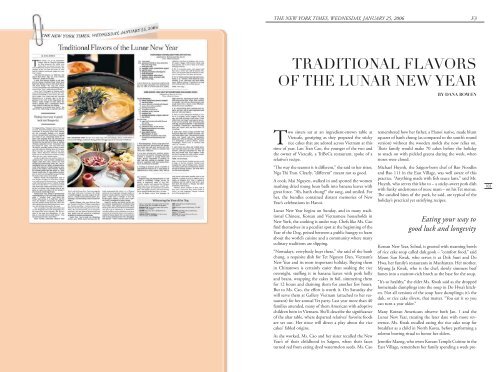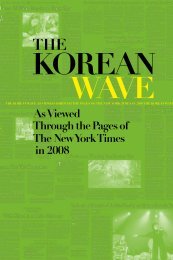The Korean Wave 2006 - Korean Cultural Service
The Korean Wave 2006 - Korean Cultural Service
The Korean Wave 2006 - Korean Cultural Service
Create successful ePaper yourself
Turn your PDF publications into a flip-book with our unique Google optimized e-Paper software.
<strong>The</strong> New York Times, wednesday, january 25, <strong>2006</strong><br />
f3<br />
Traditional Flavors<br />
of the Lunar New Year<br />
By DANA BOWEN<br />
Two sisters sat at an ingredient-strewn table at<br />
Vietcafe, gossiping as they prepared the sticky<br />
rice cakes that are adored across Vietnam at this<br />
time of year. Lan Tran Cao, the younger of the two and<br />
the owner of Vietcafe, a TriBeCa restaurant, spoke of a<br />
relative’s recipe.<br />
“<strong>The</strong> way she seasons it is different,” she said to her sister,<br />
Nga Thi Tran. Clearly, “different” meant not as good.<br />
A cook, Mai Nguyen, walked in and spotted the women<br />
mashing dried mung bean balls into banana leaves with<br />
great force. “Ah, banh chung!” she sang, and smiled. For<br />
her, the bundles contained distant memories of New<br />
Year’s celebrations in Hanoi.<br />
Lunar New Year begins on Sunday, and in many traditional<br />
Chinese, <strong>Korean</strong> and Vietnamese households in<br />
New York, the cooking is under way. Chefs like Ms. Cao<br />
find themselves in a peculiar spot at the beginning of the<br />
Year of the Dog, poised between a public hungry to learn<br />
about the world’s cuisine and a community where many<br />
culinary traditions are slipping.<br />
“Nowadays, everybody buys these,” she said of the banh<br />
chung, a requisite dish for Tet Nguyen Dan, Vietnam’s<br />
New Year and its most important holiday. Buying them<br />
in Chinatown is certainly easier than soaking the rice<br />
overnight, stuffing it in banana leaves with pork belly<br />
and beans, wrapping the cakes in foil, simmering them<br />
for 12 hours and draining them for another few hours.<br />
But to Ms. Cao, the effort is worth it. On Saturday she<br />
will serve them at Gallery Vietnam (attached to her restaurant)<br />
for her annual Tet party. Last year more than 40<br />
families attended, many of them American with adoptive<br />
children born in Vietnam. She’ll describe the significance<br />
of the altar table, where departed relatives’ favorite foods<br />
are set out. Her niece will direct a play about the rice<br />
cakes’ fabled origins.<br />
As she worked, Ms. Cao and her sister recalled the New<br />
Year’s of their childhood in Saigon, when their faces<br />
turned red from eating dyed watermelon seeds. Ms. Cao<br />
remembered how her father, a Hanoi native, made blunt<br />
squares of banh chung (as compared to the south’s round<br />
version) without the wooden molds she now relies on.<br />
<strong>The</strong>ir family would make 70 cakes before the holiday<br />
to snack on with pickled greens during the week, when<br />
stores were closed.<br />
Michael Huynh, the Saigon-born chef of Bao Noodles<br />
and Bao 111 in the East Village, was well aware of this<br />
practice. “Anything made with fish sauce lasts,” said Mr.<br />
Huynh, who serves thit kho to – a sticky-sweet pork dish<br />
with funky undertones of nuoc mam – on his Tet menus.<br />
<strong>The</strong> candied bites of the pork, he said, are typical of the<br />
holiday’s practical yet satisfying recipes.<br />
Eating your way to<br />
good luck and longevity<br />
<strong>Korean</strong> New Year, Solnal, is greeted with steaming bowls<br />
of rice cake soup called duk gook – “comfort food,” said<br />
Moon Sun Kwak, who serves it at Dok Suni and Do<br />
Hwa, her family’s restaurants in Manhattan. Her mother,<br />
Myung Ja Kwak, who is the chef, slowly simmers beef<br />
bones into a marrow-rich broth as the base for the soup.<br />
“It’s so healthy,” the elder Ms. Kwak said as she dropped<br />
homemade dumplings into the soup in Do Hwa’s kitchen.<br />
Not all versions of the soup have dumplings; it’s the<br />
duk, or rice cake slivers, that matter. “You eat it so you<br />
can turn a year older.”<br />
Many <strong>Korean</strong> Americans observe both Jan. 1 and the<br />
Lunar New Year, treating the later date with more reverence.<br />
Ms. Kwak recalled eating the rice cake soup for<br />
breakfast as a child in North Korea, before performing a<br />
solemn bowing ritual to honor her elders.<br />
Jennifer Maeng, who owns <strong>Korean</strong> Temple Cuisine in the<br />
East Village, remembers her family spending a week pre-<br />
103





